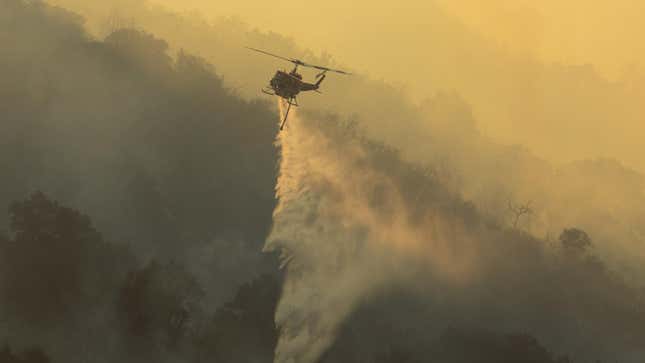
Helicopters are the vehicle of choice when it comes to providing rapid emergency relief to regions that have challenging terrain or are too remote to quickly access by automobile. Now though, human-caused climate change is exacerbating the effects of a heat dome across much the Western U.S., which is causing record-breaking temperatures that make helicopter flight unsafe. A group of motorcyclists battling deadly heat illness in Death Valley, California were unable to be reached by emergency helicopter due to the record-breaking heat last weekend.
As air gets hotter it gets thinner, making helicopter blades less effective at creating lift and affecting their ability to safely lift off the ground and navigate at low altitudes. Plus, the extreme heat can cause critical onboard systems like radios and navigation to overheat and stop working. 27-year helicopter pilot and lead pilot at Stanford University’s medical helicopter response program Douglas Evans had never been forced to cancel a flight due to excessive heat until this year. Evans told The Washington Post,
“Above 104, we can only operate on the ground for 15 minutes. It’s something that we’re going to have to be more aware of now. I see that things are warming up and I expect it just to get worse.”
Emergency helicopters in hot regions are being forced to turn down 911 calls because of the high temperatures. Both Joshua Tree and Death Valley National Parks warn visitors that helicopters may not be able to rescue stranded or distressed hikers in the heat. Sometimes these air ambulances are able to land in a cooler spot and have patients driven to the cooler location by traditional ambulances. High heat also limits the amount of weight that helicopters can safely transport, which means teams have to either leave behind some equipment, or some humans.
Beyond the machines, helicopter rescue crews also face challenges in the grueling heat. Rescue helicopters often sit on the tarmac waiting for rescue assignments, and sitting on black tarmac in direct sunlight makes the helicopter incredibly hot. The nurses and pilots at Stanford Life Flight must wear protective yet unbreathable fire resistant fly suits before boarding the sweltering chopper. Just a few minutes in the hot helicopter while wearing the fly suits effectively bakes everyone inside.
As the effects of climate change continue to rapidly worsen and evolve, our way of navigating the unpredictability of life will have to evolve, too. Can we develop helicopters that are able to produce lift when air temperatures are well beyond triple digits? Will helicopter rescues become a thing of the past? What will LAPD do with all of their free time if they can’t waste taxpayer money by circling my house every day?

